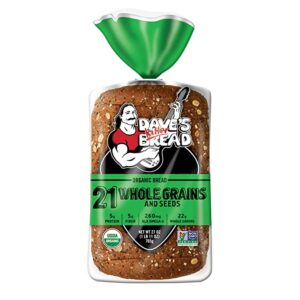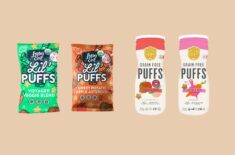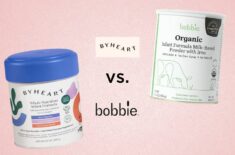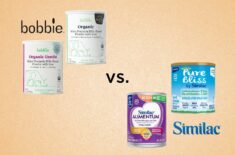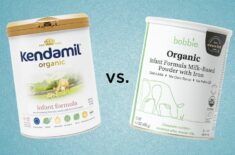Overview
Can your baby have bread when following baby-led weaning?
Absolutely! There’s no reason to hold back on bread as long as it’s done properly. Bread can be a versatile vehicle to introduce new tastes and textures to your baby.
However, not all kinds of bread are the same. Processed types of bread have been stripped of most nutritional components like bran and fiber.
Instead, your baby can get the most out of healthier bread options like sourdough, rich in antioxidants like vitamin C and folates.
Also, if you have a gluten sensitivity or allergy history, introducing bread to your baby can be a little scary. That’s okay, mama. It’s normal to feel nervous about this particular food introduction.
In this article, you’ll learn how and when to introduce bread into your baby’s diet safely. We’ll also review the risks and benefits of introducing this common staple food.
If you’re a parent experiencing gluten sensitivity or food allergies of your own, your baby may be at a high risk of developing these later in life. Find out what experts recommend below.
What Is BLW?
Baby-led weaning (BLW) is an approach that lets your baby skip jarred baby food and jump straight into eating appropriately sized-finger foods. In BLW we skip the traditional spoon-feeding puree phase. BLW lets your baby take the lead in feeding themselves, giving them more control over what and how much they eat.
Can Babies Eat Toast & Bread In Baby-Led Weaning?
Yes, you can! You can introduce your baby to bread whenever they’re ready for solids.
Common signs of readiness are: (1)
- Sits up on their own
- Shows strong head and neck control
- When you offer food, your baby opens their mouth or attempts to grab it.
- Your baby can swallow the food rather than spit it out.
- Your baby can transfer food from the front of their mouth to the back to swallow.
To do it safely, you’ll need to follow certain guidelines if you or an immediate family member have been diagnosed with celiac disease or gluten sensitivity—more on this below.
Can I Give Toast & Bread To A 6-Month-Old Baby?
Yes, you can give bread to your 6-month-old baby or as soon as they start solids.
We don’t recommend giving your baby bread when introducing first foods.
You can opt for sourdough and whole grain bread because it’s rich in fiber, vitamins, and phytochemicals, which reduces the risk of heart disease, diabetes, and obesity later in life. (2)
Many types of bread also contain common allergens such as eggs, dairy, wheat, nuts, and more. Proceed with caution or seek your pediatrician’s recommendation before introducing, especially if your immediate family members have a history of allergy to any of the above-mentioned items.
Is Bread A Healthy Food Option For Babies?
Nutrition Facts
Here’s what’s typically in 100 grams of commercial whole wheat bread: (3)
- Calories – 254 kcal
- Protein – 12.3 g
- Total fat – 2.98 g
- Total carbohydrates – 43.1 g
- Fiber – 6g
- Calcium – 163 mg
- Phosphorus – 212 mg
- Potassium – 250 mg
- Sodium – 450 mg
- Magnesium – 76.6 mg
Other Bread Considerations
Not all types of bread are nutritionally equal. Certain types might be less healthy for your family. When choosing bread, here are a few things to consider:
Bread Is A Processed Food, Unless Homemade
- Refined bread and white bread are made from processed white flour by stripping off fiber and bran. (4)
- It’s considered less healthy because it contains high amounts of sugar, salt, and processed saturated fat. (4)
- Added sugar isn’t recommended for babies under two years old because it may lead to picky eating and obesity. (5)
Bread Has A High Glycemic Load
- Refined or processed bread has high levels of simple carbohydrates, which the body can break down easily and may lead to a spike in blood and insulin levels. (6)(7)
- High glycemic foods have been associated with risk for obesity and diabetes later in life. (7)
If Parents & Caregivers Are Sensitive To Gluten And Other Common Allergens
- Please keep reading the dedicated section below for a detailed summary of what to do if you or anyone in your immediate family has a gluten intolerance or celiac disease.
What Are The Healthiest, Most Nutritious Types Of Bread For Babies?
Sprouted Grain Bread
This type of bread uses whole grains that have begun to sprout, which increases nutrient absorption. It’s packed with protein, vitamin C, zinc, iron, and magnesium. It also contains less starch and is easier to digest than commercial or refined bread. (8)
Sourdough
A 2019 study showed that sourdough has antioxidant compounds like ascorbic acid, flavonols, and folates. It inhibits antinutrients like phytic acid, which reduces the body’s absorption of nutrients. (9)
Bread Types To Avoid
Bread With Seeds And Nuts – These types of bread have been listed as common choking hazards by the USDA (The United States Department of Agriculture). (10)
Sweetbread With Added Sugar – It’s not recommended for babies under two years old to consume foods with added sugar or sweeteners. (11)
Refined Bread Or White Bread – These types of bread are made from refined grains that have been highly processed and are rid of healthy nutrients like bran and fiber. (12)
Brands We Recommend:
Dave’s Killer Bread Organic (21 Whole Grains and Seeds)
Essential Baking Company Take & Bake Sourdough



Food for Life Ezekiel 4:9 Flax Sprouted Whole Grain Bread


Alvarado Street Sprouted 100% Whole Wheat Bread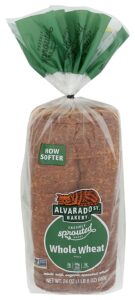


Udi’s Gluten-Free Frozen Whole Grain Bread


Angelic Bakehouse 7-Grain Sprouted Bread (No Added Sodium)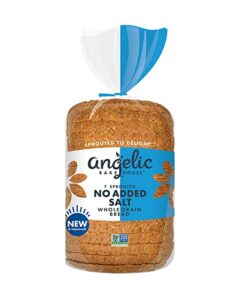

Whole Foods Organic Whole Wheat Sandwich Bread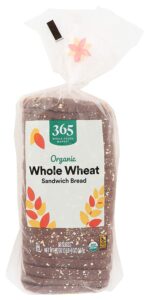

New Grains Gluten-Free Sourdough, (NON-GMO)
Can You Give Toast & Bread To Your Child Every Day?
While the AAP doesn’t recommend a strict food guide for most babies, it’s advised to offer a wide variety of unprocessed foods in their whole form. (1)
Since bread is processed food and has a high glycemic index carb, it’s best not to offer it up to your baby every day. Opt for offering it about 20-30% of the time, and when you do, make sure it’s paired with high-quality protein and fats to maximize nutrition.
How Do I Introduce Bread & Toast To My Baby in BLW?
Lightly toasted bread is ideal for baby-led weaning. You don’t want the bread to be too hard or too soft and gummy because it can be a choking hazard. It can also be safer to offer the crusty ends of the bread so they can suck on it, and it’s easier to hold.
It’s best to cut toast into sizes that support self-feeding—more on this below.
Also, remember that processed carbs like bread are best paired with high-quality fats like avocado, nut butter, or raw extra virgin olive oil and protein like eggs to balance their effect on blood sugar levels. Healthy fat is also important for babies under two years for better brain development. (13)
How To Serve Toast By Age:
For 4-6 months old
Cut the toast into long strips about two fingers’ width that they can easily grab with their palms.
For 7-12 months old
At this age, you can offer your baby small pieces of toast they can pick up with their fingers. Most babies have developed the pincer grasp, the ability to hold objects between their thumb and pointer finger.
For 12+ months old
You can give your baby a large chunk of toast for them to chew on at this age. As their chewing skills improve, you can expect less gagging. If your baby isn’t ready yet, it’s fine to let them continue eating bite-sized pieces or strips of toast.
3 Easy & Nutritious Ways to Serve Toast in BLW
Trying to cut down meal-prep time? These quick meal ideas might do the trick.
Avocado & Egg Toast – Smash avocado and top it on lightly toasted bread. Add sliced or chopped hard-boiled egg or make them scrambled.
Peanut Butter Toast With Smashed Banana – Spread toast with peanut butter or any other nut butter, and top it with a mashed banana.
Note: Peanuts are a top potential allergen, proceed with caution when introducing.
Toast Sticks To Dip In Purées And Sauces – Lightly toast bread and cut into sticks. Prepare healthy purées and sauces like black bean and sweet potato purée, yogurt, marinara sauce, or hummus. The are many possibilities, just be sure to add a variety of veggies if you can.
For more nutritious baby-led weaning recipes, check out this resource.
General Food Safety
Are Toast And Bread Choking Hazards?
Yes, toast and bread can be choking hazards. Bread containing seeds, nuts, or whole-grain kernels are listed in the USDA’s choking hazard list. (10)
Is Bread An Allergen?
Yes, bread is an allergen because it often contains wheat and gluten. It’s also usually made with other common allergens such as dairy, eggs, soy, and tree nuts.
We recommend introducing these individual allergens first before introducing bread. This is especially important if there’s a family history of food allergy or intolerance.
Gluten Intolerance, Wheat Allergy, & Celiac Disease
Many parents are nervous about introducing this food to their babies, especially if there’s a family history of gluten reactivity or other food allergies.
You may be curious about the distinction between gluten intolerance, wheat allergy, and celiac disease. Before we talk about introducing bread to your baby, let’s quickly discuss the differences between each of these conditions.
Wheat Allergy
Wheat allergy is relatively uncommon in adults, and according to Dr. Garrett Bomba of Pentucket Medical, children usually outgrow this condition by five years of age. (14)
With a wheat allergy, symptoms usually occur within minutes of eating wheat (and gluten). (14)
Common wheat allergy symptoms to watch out for are: (14)(15)
- Itchy mouth
- Swollen tongue or lips
- Nasal congestion
- Headache
- Itchy throat
- Rash, hives, or swelling of the skin
- Difficulty in breathing
- Repeated nausea or vomiting
- Diarrhea
- Abdominal pain or cramping
A wheat allergy can become life-threatening when it leads to anaphylaxis, a severe allergic reaction.
If your baby shows signs of the following, seek immediate medical care: (15)
- Chest tightness or pain
- Intermittent pulse
- Dizziness or fainting
- Flushed, pale, or blue skin
- Throat constriction and swelling
- Severe shortness of breath
When introducing bread or any new food, it’s best to serve it in small portions. Be on alert for two to three days after consuming bread in case symptoms appear.
Proceed with caution and seek your doctor’s advice before introducing allergens, especially if your family has a history of food allergies.
Gluten Intolerance/Sensitivity
Gluten sensitivity/intolerance happens when you consume gluten, a protein found in wheat, barley, rye, and other grains. It isn’t the same as an allergy but can still lead to serious health conditions. (16)
Gluten intolerance is most common in women and can develop later in life. When wheat irritates the gut lining, it makes it difficult to keep bacteria out of the intestine. This results in inflammation.
Another explanation is that some people’s bodies can’t effectively absorb carbs, causing them to ferment in their gut, leading to gut dysbiosis. (17)
Unlike a wheat allergy, which manifests within seconds or minutes, gluten intolerance symptoms usually appear within hours or even days after consuming gluten. (16)
Because symptoms are not as obvious as a wheat allergy, many people often suffer for months or years before discovering they have this intolerance.
Common gluten intolerance symptoms can include: (17)
- “Brain fog” or difficulty concentrating
- Diarrhea or constipation
- Bloating
- Headache
- Fatigue
- Abdominal pain
- Skin rash
- Anxiety
- Irritable Bowel Syndrome (IBS), or painful irritable bowel movement
Celiac Disease
Celiac disease is another serious and life-long condition associated with eating gluten. It’s an autoimmune disorder where eating gluten activates the body to attack its small intestine. It’s also characterized by serious digestive issues such as abdominal pain, diarrhea, and constipation. (16)
Celiac disease is dangerous for babies and young children because, untreated, this condition can impair the absorption of vital nutrients. Children are most likely to experience digestive symptoms than adults. (18)(19)
Here are some common symptoms of celiac disease: (19)
- Severe diarrhea
- Constipation
- Nausea
- Vomiting
- Swollen belly or bloating
- Skin rash
- Abdominal pain
As celiac disease progresses, it can lead to the inability to absorb vital nutrients.
For growing babies and young children, this can be detrimental and can lead to serious health conditions such as: (19)
- Undernourishment
- Weight loss
- Irritability
- Stunted growth
- Anemia
- Neurological conditions like attention-deficit/hyperactivity disorder (ADHD), learning disabilities, seizures, and lack of muscle control
Celiac disease is hereditary and can run in the family. If you have a first-degree family member diagnosed with celiac disease, consult your pediatrician or dietitian before introducing bread into your baby’s diet.
It’s also important to consult with your pediatrician before eliminating gluten from your baby’s diet. (20)
When asked the question: (21)
“Once you know your child has celiac disease or is gluten sensitive, how do you treat it?”
Utah-based pediatrician Dr. Cindy Gellner shares that:
“Unfortunately, the only treatment for these is a gluten-free diet.
And for most children, the change in diet relieves symptoms in a few weeks.
The longer your child keeps eating gluten, the more the intestine is damaged in celiac disease and the greater the risk for long-term problems.
But for most children with nonceliac gluten sensitivity, the diet relieves most of the symptoms completely within just a few weeks.”
How And When Can You Introduce Gluten To Babies At High Risk For Celiac Disease?
If you’re a parent with a gluten sensitivity or celiac disease, you might be wondering if your baby’s at risk of developing these conditions too.
While there’s no cure for celiac disease, you can help lessen your baby’s risk of acquiring it through a measured and timed introduction. (19)
Is Your Baby At High Risk For Celiac Disease?
Among the general population, roughly 30% of people have celiac disease genes. Still, the disease will only manifest in about 5%, according to Dr. Guandalini, Professor Emeritus at the University of Chicago, and medical director of the University of Chicago Celiac Disease Center. (22)
If a child has an immediate family member with celiac disease, such as a parent or a sibling, they are at high risk.
According to Dr. Guandalini, if a mother’s genes are linked to celiac disease, her child has a 50% chance of inheriting the genes. This fact holds even if the father carries the gene. This indicates that a baby born to a mother with celiac disease has a one in 22 chance of developing it. (22)
How And When Do You Introduce Gluten To Your Baby If They’re High-Risk?
According to UChicago’s Celiac Disease Center, babies at risk for celiac disease include the early introduction of gluten-containing products in small amounts, less than five grams per day, between ages four to six months until the age of two. That’s less than an ounce of pasta or a slice of bread. (22)
Dr. Guandalini clarified that when introducing gluten to your baby, less is more.
Their research reveals that feeding babies large amounts of gluten increased their risk of developing celiac disease compared to giving them small to moderate amounts.
He recommends feeding babies small amounts of gluten between the ages of four and six months as they continue breastfeeding or formula-feeding. Dr. Guandalini suggests: (22)
“I usually recommend starting with barley cereal. If your baby handles gluten well, go on to feed him a normal diet.”
Note: If you or anyone in your immediate family has been diagnosed with celiac disease, please consult with your pediatrician before introducing gluten-containing grains to your baby’s diet.
REFERENCES:
- https://www.cdc.gov/nutrition/infantandtoddlernutrition/foods-and-drinks/when-to-introduce-solid-foods.html
- https://foodinsight.org/whole-grain-fact-sheet/
- https://fdc.nal.usda.gov/fdc-app.html#/food-details/335240/nutrients
- https://www.srnutrition.co.uk/2019/05/bread-for-babies-whats-the-low-down/
- https://www.ncbi.nlm.nih.gov/pmc/articles/PMC6520717/
- https://healthy-kids.com.au/food-nutrition/5-food-groups/breads-cereals/
- https://lpi.oregonstate.edu/mic/food-beverages/glycemic-index-glycemic-load
- https://www.health.harvard.edu/blog/sprouted-grains-nutritious-regular-whole-grains-2017110612692
- https://pubmed.ncbi.nlm.nih.gov/31218698/
- https://wicworks.fns.usda.gov/sites/default/files/media/document/English_ReducingRiskofChokinginYoungChildren.pdf
- https://www.cdc.gov/nutrition/infantandtoddlernutrition/foods-and-drinks/foods-and-drinks-to-limit.html
- https://www.helpguide.org/articles/healthy-eating/choosing-healthy-carbs.htm
- https://kidshealth.org/en/parents/fat.html
- https://pmaonline.com/posts/allergy-asthma/wheat-allergy-gluten-intolerance/
- https://www.mayoclinic.org/diseases-conditions/wheat-allergy/symptoms-causes/syc-20378897
- https://www.nm.org/healthbeat/healthy-tips/celiac-disease-vs-gluten-intolerance-infographic
- https://my.clevelandclinic.org/health/diseases/21622-gluten-intolerance
- https://acaai.org/allergies/allergic-conditions/food/wheat-gluten/
- https://www.mayoclinic.org/diseases-conditions/celiac-disease/symptoms-causes/syc-20352220
- https://www.health.harvard.edu/blog/3-reasons-not-put-child-gluten-free-diet-unless-doctor-says-201606079760
- https://healthcare.utah.edu/the-scope/shows.php?shows=0_jhjrrvve
- http://www.cureceliacdisease.org/wp-content/uploads/CdC_Newsletter_IssueOne_032019_v6.pdf



